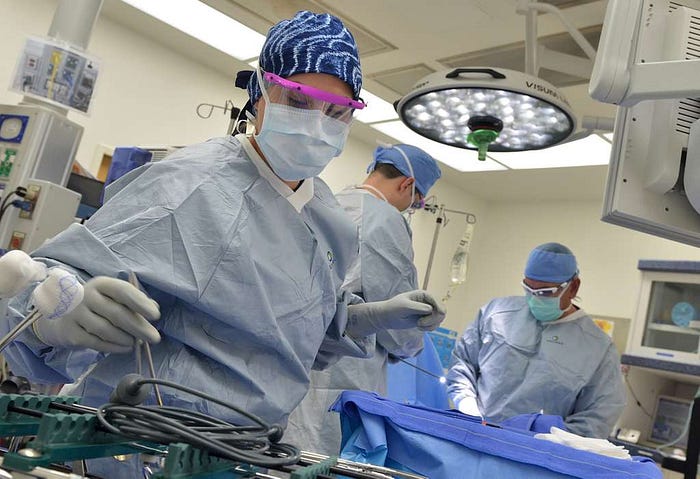
When facing a medical condition that may require surgery, it’s normal to have questions. Two common approaches in the surgical world are general surgery and laparoscopy. Understanding what these methods involve can help you make informed decisions and ease your concerns.
This blog explores general surgery and laparoscopy, how they are used, and what patients can expect before, during, and after surgery.
What Is General Surgery?
General surgery is a broad field of medicine focused on treating a wide range of conditions that may require surgical intervention. General surgeons are trained to operate on multiple areas of the body, including the abdomen, digestive system, breast, skin, and soft tissues.
These surgeons handle both routine procedures and emergency cases. From removing an inflamed appendix to repairing hernias or treating abdominal trauma, general surgeons are often on the front lines of surgical care.
Common Procedures in General Surgery
- Appendectomy — Removal of the appendix, typically due to appendicitis.
- Cholecystectomy — Removal of the gallbladder, often due to gallstones.
- Hernia repair — Surgical correction of hernias, where organs protrude through weak abdominal walls.
- Intestinal surgery — Removal or repair of portions of the intestines in cases of blockage, cancer, or inflammation.
- Breast surgery — For cysts, lumps, or breast cancer.
- Skin and soft tissue surgery — Removal of abscesses, cysts, or benign tumors.
These procedures can be done using open surgery or, where appropriate, minimally invasive techniques like laparoscopy.
What Is Laparoscopy?
Laparoscopy, often called keyhole surgery, is a modern, minimally invasive surgical technique. It uses small incisions and a device called a laparoscope — a thin tube with a camera and light at the end.
During the procedure, the abdomen is inflated with gas to create space, and the laparoscope sends real-time images to a monitor. Surgeons then perform the operation using specialized tools inserted through tiny incisions.
Laparoscopy is known for faster recovery, minimal pain, and reduced risk of complications. It has become the preferred method for many abdominal and pelvic procedures.
Common Laparoscopic Surgeries
- Gallbladder removal (laparoscopic cholecystectomy)
- Appendectomy
- Hernia repair
- Treatment of endometriosis or ovarian cysts
- Colorectal surgeries
- Bariatric (weight loss) surgery
- Diagnostic laparoscopy for unexplained abdominal or pelvic pain
In some cases, diagnostic laparoscopy is used to examine internal organs when non-invasive imaging doesn’t provide enough information.
Why Laparoscopy Is Gaining Popularity
Patients and surgeons alike prefer laparoscopic methods when possible due to multiple benefits:
- Smaller incisions, leading to minimal scarring
- Less post-operative pain compared to open surgery
- Faster recovery time, allowing patients to return to normal activities sooner
- Shorter hospital stays, sometimes even same-day discharge
- Lower risk of infection, due to reduced tissue exposure
Before Surgery: What to Expect
Whether you’re undergoing general or laparoscopic surgery, preparation is essential:
- Pre-operative evaluation: This includes medical history review, blood tests, imaging (like an ultrasound or CT scan), and anesthesia clearance.
- Fasting: Usually required for 6–8 hours before surgery.
- Medication adjustments: Some medications, especially blood thinners, may need to be stopped temporarily.
- Consent: The surgical team will explain the procedure, risks, and alternatives before you sign consent forms.
Always share full information about your health, current medications, and any allergies with your medical team.
During Surgery
In most cases, surgery is performed under general anesthesia, meaning you’ll be fully asleep and pain-free during the procedure. The surgical duration depends on the condition being treated but typically ranges from 30 minutes to a few hours.
The medical team monitors your vitals throughout the process to ensure your safety. In laparoscopic procedures, the camera helps the surgeon visualize and perform with high precision.
After Surgery: Recovery and Follow-up
Recovery After Laparoscopic Surgery:
- Discharge often happens the same day or within 24 hours.
- Light activity can usually resume within a couple of days.
- Mild pain or bloating is common but manageable with painkillers.
- Full recovery typically occurs within 1 to 2 weeks.
Recovery After Open Surgery:
- Hospital stay may be longer (2 to 5 days).
- Pain may be more intense, requiring stronger medication.
- Recovery takes longer, typically 4 to 6 weeks.
- Regular follow-up is important to monitor wound healing and prevent complications.
Are There Risks Involved?
All surgeries carry some risk. Common risks include infection, bleeding, or reaction to anesthesia. However, with experienced surgeons and proper hospital facilities, complications are rare.
Specific to laparoscopy, risks include:
- Injury to internal organs
- Blood vessel damage
- Gas-related complications like shoulder pain
In rare situations, a laparoscopic procedure may need to be converted to open surgery due to unforeseen complications.
When Open Surgery Is Preferred
Laparoscopy is ideal for many situations, but open surgery is sometimes necessary. Your surgeon may choose open surgery when:
- There’s significant scarring from previous procedures
- The surgical area is too large or complex
- There’s a tumor that requires full access
- The patient is unstable and needs rapid intervention
The surgeon’s goal is always the safest, most effective approach for your condition.
Choosing the Right Surgeon
Choosing a skilled and trusted surgeon is vital. Here’s what to look for:
- Experience in laparoscopic and general procedures
- Hospital reputation and infection control protocols
- Clear communication and willingness to answer questions
- Availability for follow-ups and emergencies
- Recommendations from family doctors or friends
Always feel comfortable asking your surgeon about their experience and success rates with the procedure you need.
Final Thoughts
Understanding general surgery and laparoscopy helps reduce anxiety when facing surgery. While general surgery covers a wide range of conditions, laparoscopy offers a less invasive and faster-healing alternative for many of them.
Discuss all options with your doctor. With the right team and proper planning, surgical care can be safe, effective, and a step toward better health.
Comments on “General Surgery & Laparoscopy: A Patient’s Guide”